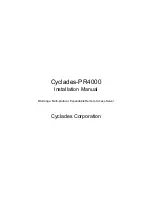
51
Proprietary Information: Not for use or disclosure except by written agreement with Calix.
© 2001-2007 Calix. All Rights Reserved.
The second aspect of proper grounding is for the protection and survivability of the
electronics equipment. High voltage spikes that are present during electrical storms and static
buildup on power utility lines have been known to cause a great deal of damage to electronic
equipment. When the voltage potentials reach sufficient amplitude, flashovers take place. In
most cases, damage is caused by the super heating present during the flashover. The high
voltage potentials that are induced into AC utility conductors and communications cables
during electrical storms are of a wavelength that approaches the RF spectrum. To be
effective in the discharging of induced RF energy, grounding conductors must provide a low
impedance path to earth. Keeping conductors as short as possible and using the most direct
path, free of sharp bends, will help to lower the impedance of the ground circuit.
Note:
Grounding conductors should never be placed inside a metallic conduit unless bonded
at both ends of the conduit so that the conduit itself becomes the conductor.
Testing the Earth Electrode
The earth electrode is the bonding or connection point to the earth. The most common earth
electrodes are ground rods, metallic cold water pipes, underground grids and water wells that
use steel pipe. The ability of a grounding system to safely dissipate unwanted or harmful
potentials into the earth, depends on the total resistance of the electrode, the resistance
between the conducting surface of the electrode and the conducting surface of the soil that it
is in. The conductivity of the earth near and around the grounding system depends on the
chemical makeup and ambient moisture content of the soil.
The testing of an electrode measures the effectiveness of the earth electrode to provide
electrical contact with the earth. The lower that the resistance to the earth is, the more
effective the ground system will be in dissipating energy safely.










































